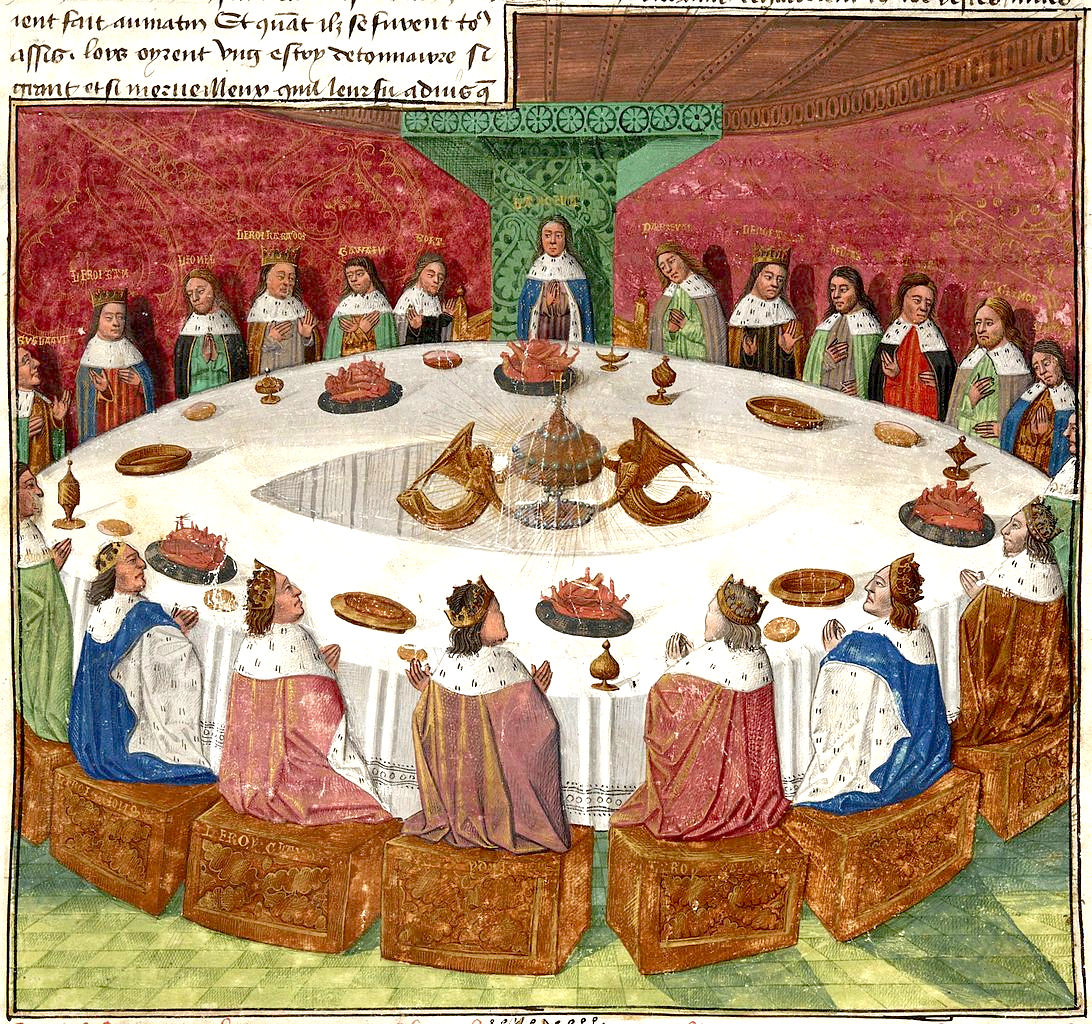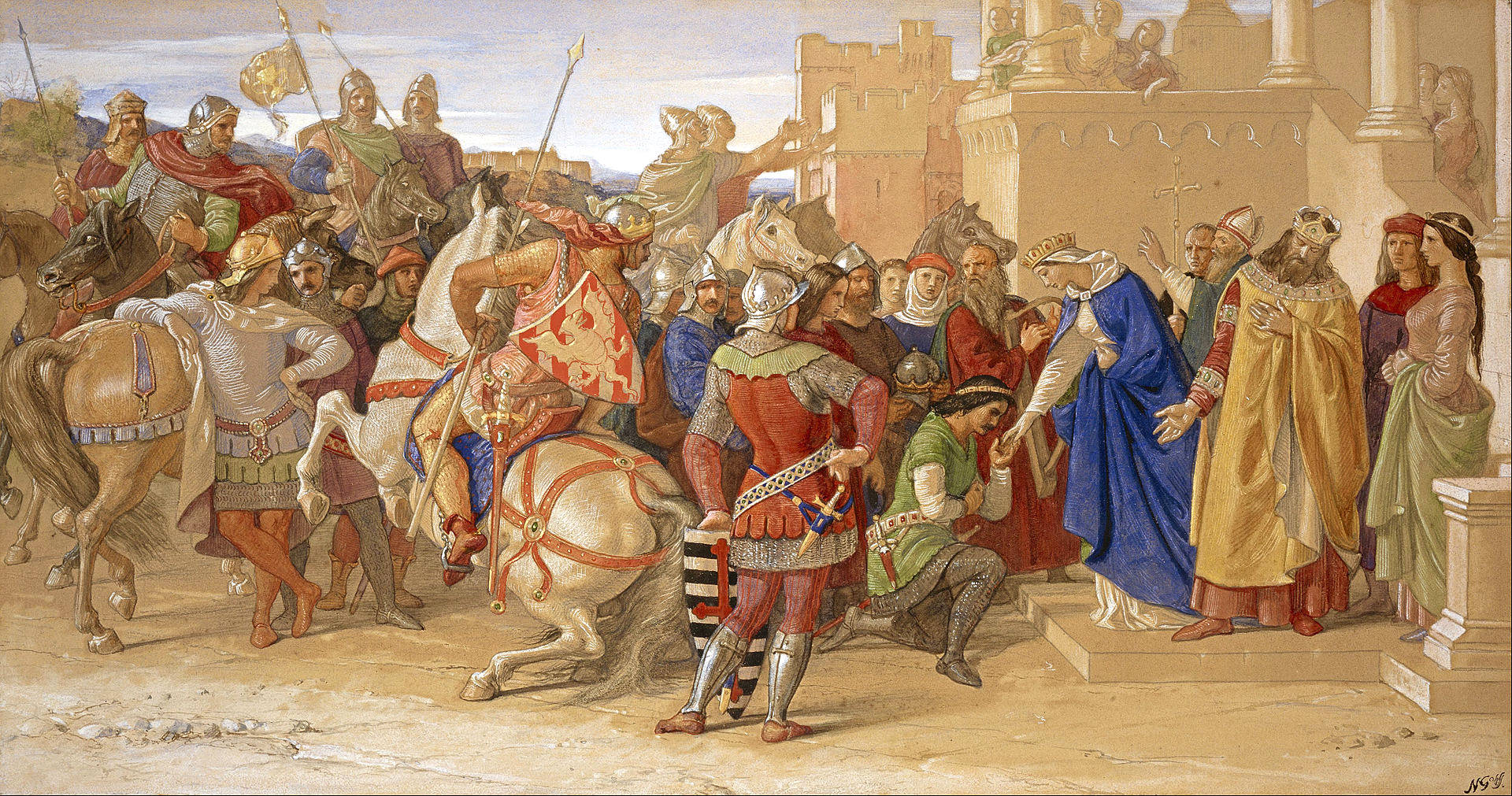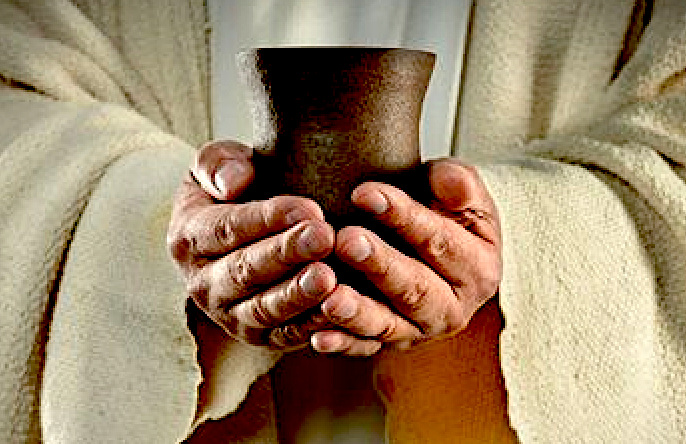
Galahad (/ˈɡæləhæd/), sometimes referred to as Galeas (/ɡəˈliːəs/) or Galath (/ˈɡæləθ/), among other versions of his name, is a knight of King Arthur's Round Table and one of the three achievers of the Holy Grail in Arthurian legend. He is the illegitimate son of Sir Lancelot du Lac and Lady Elaine of Corbenic and is renowned for his gallantry and purity as the most perfect of all knights. Emerging quite late in the medieval Arthurian tradition, Sir Galahad first appears in the Lancelot–Grail cycle, and his story is taken up in later works, such as the Post-Vulgate Cycle, and Sir Thomas Malory's Le Morte d'Arthur.
The story of Galahad and his quest for the Holy Grail is a relatively late addition to the Arthurian legend. Galahad does not feature in any romance by Chrétien de Troyes, or in Robert de Boron's Grail stories, or in any of the continuations of Chrétien's story of the mysterious castle of the Fisher King. He first appears in a 13th-century Old French Arthurian epic, the interconnected set of romances known as the Vulgate Cycle. His name could have been derived from the Welsh name Gwalchaved, meaning "Falcon of Summer".
The original conception of Galahad, whose adult exploits are first recounted in the fourth book of the Vulgate Cycle, may have come from the mystical Cistercian Order. According to some interpreters, the philosophical inspiration of the celibate, otherworldly character of the monastic knight Galahad came from this monastic order set up by St. Bernard of Clairvaux.Upon reaching adulthood (in medieval definition) of 15 years old, Galahad is finally united with his father Lancelot, who had never met him before that (not even during the years of living with Elaine). Lancelot knights Galahad after having been bested by him in a duel, the first and only time that Lancelot ever lost in a fair fight to anyone.
Galahad is then brought to King Arthur's court at Camelot during Pentecost, where he is accompanied by a very old knight who immediately leads him over to the Round Table and unveils his seat at the Siege Perilous, an unused chair that has been kept vacant for the sole person who will succeed in the quest of the Holy Grail. For all others who have aspired to sit there, it has proved to be immediately fatal. Galahad survives this test, witnessed by Arthur who, upon realising the greatness of this new knight, leads him out to the river where a magic sword lies in a stone with an inscription reading "Never shall man take me hence but only he by whose side I ought to hang; and he shall be the best knight of the world." (The embedding of a sword in a stone is also an element of the legends of Arthur's original sword, the sword in the stone. In Malory's version, this is the sword that had belonged to Balin.) Galahad accomplishes this test with ease, and Arthur swiftly proclaims him to be the greatest knight ever. Galahad is promptly invited to become a Knight of the Round Table, and soon afterwards, Arthur's court witnesses an ethereal vision of the Grail. The quest to seek out this holy object is begun at once.
All of the Knights of the Round Table set out to find the Grail. It is Galahad who takes the initiative to begin the search for the Grail; the rest of the knights follow him. Arthur is sorrowful that all the knights have embarked thus, for he discerns that many will never be seen again, dying in their quest. Arthur fears that it is the beginning of the end of the Round Table. This might be seen as a theological statement that concludes that earthly endeavours must take second place to the pursuit of the holiness. Galahad, in some ways, mirrors Arthur, drawing a sword from a stone in the way that Arthur did. In this manner, Galahad is declared to be the chosen one. The Cistercian-Bernardine concept of Catholic warrior asceticism that so distinguishes the character of Galahad also informs St. Bernard's projection of ideal chivalry in his work on the Knights Templar, the Liber ad milites templi de laude novae militiae. Significantly, in the narratives, Galahad is associated with a white shield with a vermilion cross, the very same emblem given to the
Knights Templar by Pope Eugene III.
GRAIL QUEST
Upon reaching adulthood (in medieval definition) of 15 years old, Galahad is finally united with his father Lancelot, who had never met him before that (not even during the years of living with Elaine). Lancelot knights Galahad after having been bested by him in a duel, the first and only time that Lancelot ever lost in a fair fight to anyone. Galahad is then brought to King Arthur's court at Camelot during Pentecost, where he is accompanied by a very old knight who immediately leads him over to the Round Table and unveils his seat at the Siege Perilous, an unused chair that has been kept vacant for the sole person who will succeed in the quest of the Holy Grail. For all others who have aspired to sit there, it has proved to be immediately fatal. Galahad survives this test, witnessed by Arthur who, upon realising the greatness of this new knight, leads him out to the river where a magic sword lies in a stone with an inscription reading "Never shall man take me hence but only he by whose side I ought to hang; and he shall be the best knight of the world." (The embedding of a sword in a stone is also an element of the legends of Arthur's original sword, the sword in the stone. In Malory's version, this is the sword that had belonged to Balin.) Galahad accomplishes this test with ease, and Arthur swiftly proclaims him to be the greatest knight ever. Galahad is promptly invited to become a Knight of the Round Table, and soon afterwards, Arthur's court witnesses an ethereal vision of the Grail. The quest to seek out this holy object is begun at once.
All of the Knights of the Round Table set out to find the Grail. It is Galahad who takes the initiative to begin the search for the Grail; the rest of the knights follow him. Arthur is sorrowful that all the knights have embarked thus, for he discerns that many will never be seen again, dying in their quest. Arthur fears that it is the beginning of the end of the Round Table. This might be seen as a theological statement that concludes that earthly endeavours must take second place to the pursuit of the holiness. Galahad, in some ways, mirrors Arthur, drawing a sword from a stone in the way that Arthur did. In this manner, Galahad is declared to be the chosen one.
Further uniquely among the Round Table, Galahad is capable of performing miracles such as banishing demons and healing the sick. For the most part, he travels alone during the Grail Quest, smiting (and often sparing) his enemies, rescuing fellow knights including Percival and saving maidens in distress until he is finally reunited with Bors and Percival. Together, the three blessed virgin knights come across Percival's sister, who leads them to the mystical Ship of Solomon. They use it to cross the sea to an island where Galahad finds King David's sword.
In
the legend of King
Arthur Pendragon, he is famous for his quest to
find the Holy
Grail, Cup of Jesus
Christ, is a search for the divine in all of us.

Knights
of the Round Table, depart in their quest to find the Holy Grail
KNIGHTS OF THE ROUND TABLE
The Knights of the Round Table, are the knights of the fellowship of King Arthur in the literary cycle of the Matter of Britain. First appearing in literature in the mid-12th century, the Knights are an order dedicated to ensuring the peace of Arthur's kingdom following an early warring period, entrusted in later years to undergo a mystical
quest for the Holy
Grail. The Round Table at which they meet is a symbol of the equality of its members, who range from sovereign royals to minor nobles.
The various stories in the cycle present an assortment of knights from all over Great Britain and abroad, some of whom are even from outside of Europe.
By the end of Arthurian prose cycles, the knights split up into groups of warring factions following the revelation of Lancelot's adultery with King Arthur's wife,
Queen
Guinevere. In the same tradition, Guinevere is featured with her own personal order of young warriors and knights, known as the Queen's Knights. Some of these romances retell the story of the Knights of the Old Table, led by Arthur's father, Uther Pendragon, whilst other tales focus on the members of the 'Grail Table'; these were the followers of ancient Christian
Joseph of
Arimathea, with his Grail Table later serving as the inspiration for Uther and Arthur's subsequent Round Tables.
THE
MOST
MENTIONED KNIGHTS OF THE ROUND TABLE A - Z
Sir Agravain
King Arthur
Sir Bedivere
Sir Bors de Ganis
Sir Dagonet
Sir Ector
Sir Gaheris
Sir Galahad
Sir Gareth
Sir Gawain
Sir Geraint
Sir Kay
Sir Lamorak
Sir
Lancelot
Sir
Mordred
Sir Percival
Sir Tristan
EXCALIBUR
Some believe that
'Excalibur' was the sword King Arthur pulled out of the stone to claim his right to the throne of Britain.
Excalibur means ‘cut-steel’ and it is attributed with magical properties. Supposedly, it was formed with the heat from dragon-fire.
The sword served the King well until the scabbard, the sword cover, which was supposedly magical in nature, went missing. After this, he was defeated in battle and fearing his death, Arthur gave
Excalibur to his Knight, Sir Bedivere to keep.



